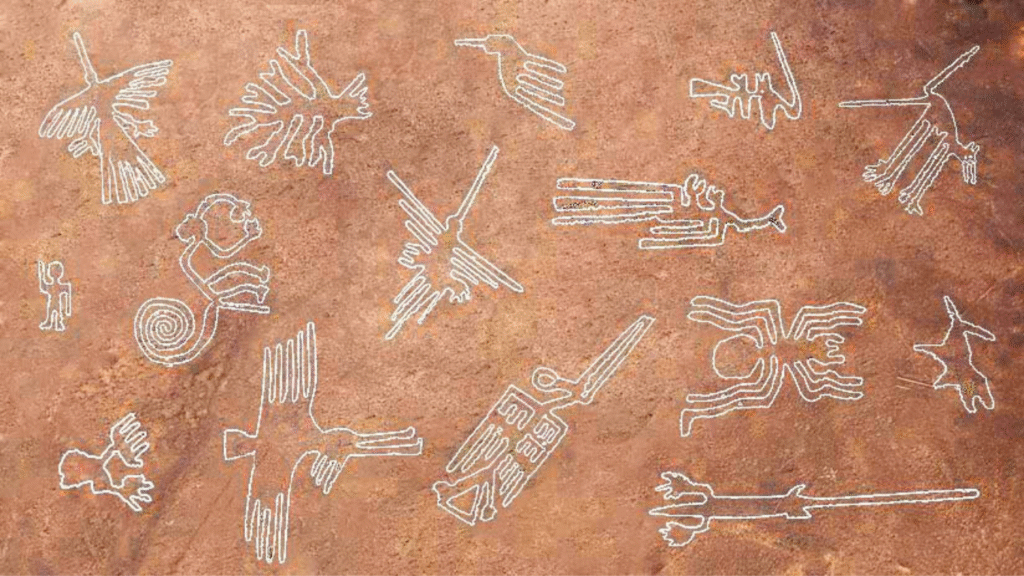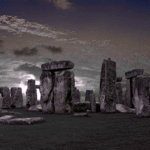In Peru’s Nazca Desert, giant drawings of animals, plants, and shapes stretch across the sand, visible only from the sky. Created between 500 BC and 500 AD by the Nazca people, these massive geoglyphs, known as the Nazca Lines, cover miles and include figures like a hummingbird, monkey, and spirals, some up to 1,200 feet long. Made by clearing dark rocks to reveal lighter soil, they’ve survived thanks to the desert’s dry climate. Why were they made? No one knows for sure. Theories suggest they were for rituals, astronomy, or even messages to gods. Some even whisper of alien involvement. Rediscovered in the 1920s by pilots, the lines baffle archaeologists and draw tourists to this UNESCO World Heritage Site. Their scale, precision, and mystery make the Nazca Lines one of Earth’s most intriguing wonders, inviting us to ponder the minds of an ancient culture that left their mark in the sand.
The History of the Nazca Lines
The Nazca Lines were created by the Nazca culture, thriving in southern Peru from about 100 BC to 800 AD. Between 500 BC and 500 AD, they etched hundreds of figures into the desert by removing dark, oxidized stones to expose pale soil beneath. These geoglyphs include animals like birds and lizards, plants, and geometric patterns, some stretching over a thousand feet. The dry, windless desert preserved them, untouched for centuries. Rediscovered in the 1920s when planes flew over, they stunned the world. Archaeologists believe they had cultural or spiritual meaning, but no written records explain their purpose. The Nazca’s skill in creating such massive, precise designs without aerial views sparks wonder. Today, as a UNESCO site, the lines draw researchers and visitors, all trying to crack the code of why these ancient people turned their desert into a giant canvas.
Creation by the Nazca Culture
The Nazca people made the lines by clearing surface stones, revealing lighter earth. Some figures, like a 600-foot condor, required careful planning. They likely used ropes and stakes for precision, but how they designed images only visible from above is a puzzle. Small-scale models or spiritual guidance might have helped. The process took years, suggesting deep purpose. Pottery and ruins nearby show the Nazca were skilled farmers and artists, but their geoglyphs stand out as their boldest creation, leaving clues to a culture we’re still trying to understand.
Rediscovery in the Modern Era
In the 1920s, pilots flying over Peru’s desert spotted the Nazca Lines, revealing their scale to the world. Before then, locals knew of them, but their size went unnoticed without aerial views. By the 1930s, archaeologists like Toribio Mejía Xesspe studied them, sparking global interest. Early theories tied them to irrigation or rituals. Planes made them famous, and today, tourists fly over in small aircraft to see the figures. Their rediscovery turned a forgotten art into a global mystery, pushing scholars to dig deeper into why the Nazca created these desert masterpieces.
How Were the Nazca Lines Made?
Crafting the Nazca Lines was a massive task for a people with simple tools. The Nazca cleared dark, sun-baked stones from the desert floor to expose lighter soil, forming shapes like spiders and trees. Some lines stretch miles, requiring precise planning. They likely used ropes, stakes, and small models to map designs, but how they scaled them up without seeing from above is unclear. The desert’s dryness and lack of wind kept the lines intact for centuries. Teams of workers, possibly guided by spiritual leaders, spent years on these geoglyphs. The effort shows a culture dedicated to something bigger—maybe gods or stars. The mystery of their methods, combined with the lines’ sheer size, makes the Nazca Lines a stunning example of ancient ingenuity that still leaves us guessing.
Techniques and Tools
The Nazca used basic tools—wooden stakes, ropes, and their hands—to create the lines. They scraped away dark pebbles to reveal pale soil, forming shallow trenches about a foot deep. Some designs, like a 200-foot monkey, needed exact measurements. They might have used grids or small sketches to guide them. Workers walked paths to flatten the soil, creating wide lines. The process was slow, with entire communities likely involved. The desert’s stable climate preserved their work, but the precision without aerial views amazes experts, hinting at skills or beliefs we don’t fully grasp.
Preservation by the Desert
The Nazca Desert’s unique conditions saved the lines for millennia. With almost no rain—less than an inch a year—and minimal wind, the geoglyphs stayed undisturbed. The dark surface stones, baked by the sun, contrast sharply with the light soil below, keeping the designs vivid. Erosion is rare in this arid zone, unlike wetter regions where lines would fade. Human activity, like footsteps or vehicles, now poses the biggest threat, prompting protective measures. This natural preservation makes the lines a time capsule, letting us marvel at an ancient culture’s work.
Theories About Their Purpose
Why did the Nazca create these giant drawings? Theories abound, but none are certain. Many believe they were for rituals, possibly to honor gods or beg for water in the dry desert. Their alignment with stars or solstices suggests an astronomical role, like a calendar for planting. Some think they were sacred paths walked in ceremonies. Wilder ideas point to aliens, claiming the lines were signals or landing strips. No evidence supports extraterrestrial theories, but the aerial perspective fuels them. The Nazca left no writings, so archaeologists rely on pottery, ruins, and the lines themselves. Each theory reflects the lines’ mystery, showing a culture with big ideas and bigger ambition, leaving us to wonder what drove them to etch their desert with such bold art.
Astronomical and Calendrical Theories
Some scholars think the Nazca Lines tracked stars or seasons. Certain figures, like the spider, align with constellations or solstices, suggesting a calendar for farming or rituals. The Nazca relied on agriculture, so knowing when to plant was vital. Lines pointing to water sources or celestial events might have guided their lives. Astronomer Maria Reiche spent decades mapping these alignments, believing they were a giant star chart. While compelling, this theory doesn’t explain all designs, leaving room for other ideas about their spiritual or cultural role.
Religious and Ritualistic Purposes
The Nazca Lines likely held spiritual meaning. Many figures, like birds or plants, tie to Nazca beliefs about nature and gods. The desert’s dryness made water sacred, so some lines may have been pleas for rain. Paths among the geoglyphs suggest ceremonial walks, maybe by priests or communities. Nearby temples and graves support this, hinting at worship or offerings. The effort to create such huge designs shows deep devotion, but without texts, we can only guess what gods or spirits the Nazca hoped to reach with their desert art.
Extraterrestrial Hypotheses
Some claim the Nazca Lines were made for aliens, seen only from the sky. Popularized by writers like Erich von Däniken, this idea sees them as landing strips or signals for extraterrestrial visitors. The lines’ size and aerial visibility fuel this, but no artifacts or evidence support it. Scientists dismiss it, pointing to the Nazca’s own skill and culture. Still, the theory persists in pop culture, as the lines’ strangeness invites wild ideas. It reflects our love for mystery, even if human ingenuity is the likelier answer.
The Nazca Lines in Modern Times
Today, the Nazca Lines are a global wonder, drawing tourists and scholars to Peru. Small planes offer aerial tours, letting visitors see the hummingbird or whale from above, a thrill that boosts local tourism. As a UNESCO site, they’re protected, but foot traffic and illegal vehicles threaten their fragile surface. Preservation efforts include restricted zones and patrols. The lines star in documentaries, books, and sci-fi, keeping their mystery alive. They inspire artists and spark debates about ancient knowledge versus alien tales. Environmental changes, like rare rains, now risk erosion, raising concerns. The Nazca Lines remain a bridge to an ancient past, their beauty and secrets pulling us in, urging us to protect and ponder this incredible desert gallery.
Tourism and Preservation Challenges
The Nazca Lines attract thousands yearly, with plane tours offering stunning views of the geoglyphs. This tourism fuels Peru’s economy but risks damage. Footsteps, tire tracks, and even a 2018 truck incident scarred some lines. As a UNESCO site, they’re guarded, with restricted access and drone bans. Guides educate visitors to tread lightly. Climate change brings rare rains, threatening erosion. Preservation balances access with protection, ensuring the lines endure. Their fragility reminds us to respect this ancient art while marveling at its scale and mystery.
Cultural Impact and Pop Culture
The Nazca Lines shine in global culture, from Ancient Aliens episodes to books claiming extraterrestrial links. Movies and art feature their eerie shapes, making them a symbol of mystery. In Peru, they’re a source of pride, tied to indigenous heritage. Schools teach their history, and festivals celebrate Nazca culture. Conspiracy theories keep them in headlines, but archaeologists stress their human origins. Their image graces stamps, logos, and souvenirs, embedding them in modern life. The lines’ blend of beauty and enigma ensures they remain a cultural touchstone, sparking wonder across the world.
Why the Nazca Lines Fascinate Us
The Nazca Lines grip our imagination because they defy easy answers. Their size, visible only from the sky, feels impossible for an ancient people without flight. The mystery of their purpose—rituals, stars, or gods—invites endless guesses. Pop culture amplifies their allure, blending fact with tales of aliens or lost wisdom. They tap into our love for puzzles, hinting at a culture we barely know. The desert’s preservation makes them a vivid link to the past, yet their silence fuels debate. Whether spiritual paths or cosmic maps, the lines remind us Earth holds secrets, urging us to explore and imagine what drove the Nazca to create such bold, lasting art.
The Allure of the Unknown
Humans crave mysteries, and the Nazca Lines deliver. Their aerial design, unseen by their makers, sparks questions about how and why they were made. Without records, we guess at their meaning—religious, practical, or cosmic. This gap lets us dream up stories, from gods to aliens. The lines’ strangeness feels like a challenge, pushing us to solve a 2,000-year-old puzzle. Their survival in the desert adds a haunting beauty, making them a symbol of the unknown that keeps us curious and searching for answers.
Pop Culture’s Role
From Chariots of the Gods to TV shows, the Nazca Lines star in tales of ancient mysteries. Documentaries explore their creation, while sci-fi spins alien yarns. Their images appear in art, games, and ads, making them a shorthand for enigma. In Peru, they’re cultural icons, inspiring pride and festivals. Pop culture turns their story into a global obsession, blending fact and fantasy. This spotlight keeps the lines relevant, fueling debates and drawing new generations to wonder about the Nazca’s desert masterpiece.
Conclusion
The Nazca Lines of Peru remain one of Earth’s great mysteries, their giant shapes etched in the desert holding secrets of an ancient culture. Created with simple tools, their scale and aerial design stun us, hinting at rituals, stars, or gods. From their rediscovery to their role in tourism and pop culture, they captivate with their beauty and enigma. Theories of astronomy, worship, or even aliens keep us guessing, while preservation fights to save them. The lines connect us to the Nazca people, their bold vision still alive in the sand. As we gaze from planes or screens, they remind us that some mysteries endure, inviting us to dream and explore.



